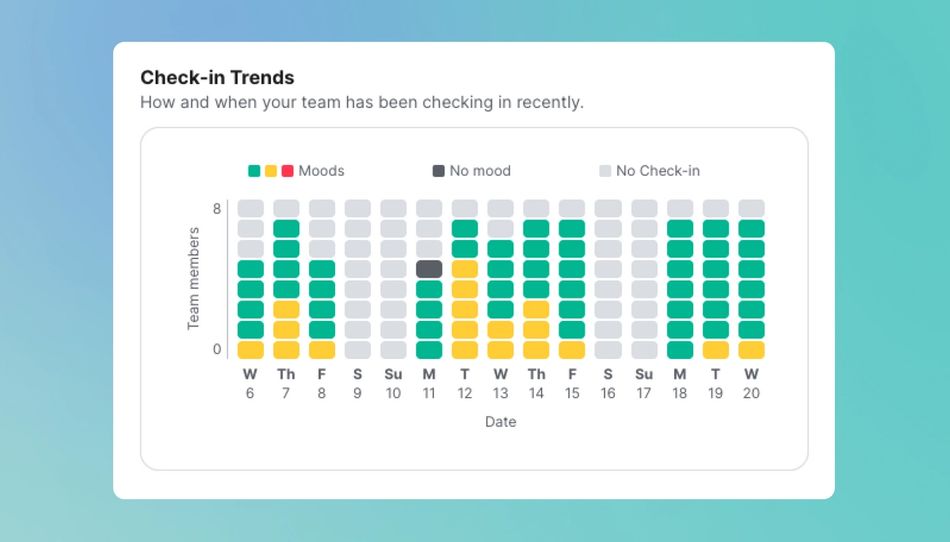
Effective and respected team managers are attuned to the collective state of their teams. They know when to check in, offer support, create moments of celebration, and add on or hold back additional work in order to keep their teams moving forward. It can be a difficult dance, but it’s most often accomplished by ensuring that team members feel supported and seen.
One practice we’ve used at Range forever — and that’s built into our product — is sharing how we’re showing up to work each day. We use a red/yellow/green check-in to signal our mood or how we’re feeling to our teammates. While that may sound simple or silly, it can be incredibly helpful to everyone on a team, not just managers. And when this information is presented in a way that shows trends over time, such as in our Team Dashboard, the insight offered can prove quite valuable to team leaders.
If you’re wondering what you might do with this team insight, we’ve got four suggestions ready to share with you.
1. Know when an extra check-in is needed
Checking in with our team shouldn’t happen only in regularly scheduled meetings or 1:1s. Seeing that someone has signaled that they are feeling overwhelmed is a prime opportunity for us as people managers to take off our strategy or operations hats and check in with a teammate human-to-human — unplanned.
“How are you doing today? Is there anything you need?” Our team members may not have answers to our questions, and we may not have solutions ready, but this recognition and support can be the start of a conversation that turns things around.
2. Get ahead of declines in employee engagement
Disengaged employees cost US companies approximately $550 billion per year resulting from turnover, absenteeism, burnout, and low levels of wellness according to research from The Engagement Institute. Knowing how employees feel about the work they’re doing, as well as how they’re showing up to work, is one way to get ahead of disengagement.
If we create an environment where people show up to work knowing what is expected of them and feeling connected to one another, then we’ll have created a place where people want to be. To do that, we must create opportunities for people to not only communicate how they’re feeling about their work but also to see how their peers are feeling (and give them opportunities to speak on what’s working for them and what isn’t). Something as simple as a “Hey, I saw you check-in in as red today” and “I wanted to see if I could help with anything on your plate” can make a world of difference to a team member experiencing high levels of stress or distraction outside of work, particularly if there’s seemingly never a reprieve in sight.
As we discussed in our panel discussion on leadership shaping the remote employee experience, that experience directly contributes to the effectiveness and performance of our companies. As leaders, it’s imperative we understand our impact on this journey and be intentional about the culture we’re building.
3. Better manage employee burnout on your team
We all manage stress differently, and some of us even think that we thrive on it. While that may be true for some, regular, prolonged periods of stress and exhaustion brought on from overworking ourselves (or being overworked) result in employee burnout.
We’ve previously talked about how to prevent burnout on teams, noting checking in with our people as one tactic. Check-in trends in Range’s Team Dashboard are certainly a valuable signal to help managers monitor trending moods across their teams, but that’s a starting point. Ask how things are going, what they think of the work they’re doing, what might be causing them stress, and how you can help. You can do that as their manager or as their colleague.
Modeling vulnerability makes a difference
Sharing our emotions with others is really important. Research shows that vulnerability is a key part of human connection, and that’s as much applicable to our professional relationships as it is to the relationships in our personal lives outside of work. Our well-being depends on human connection, and it’s why we encourage sharing — not withholding — emotions at work.
Whether you’ve seen team members feeling blue, frustrated, or stressed, encourage them to share this part of themselves with the team by modeling the behavior of sharing emotions. As you start to share more about how you’re feeling, others will follow. And start simple. Share how your weekend went during a 1:1 with a team member who’s recently been checking in as red or yellow more consistently. Even consider making these red/yellow/green check-ins part of how your team opens meetings — we call these opening rounds. It builds on itself, and pretty soon you’ll be talking about your tensions and fears during team meetings and even company all hands.
Run your team on Range
Finally know what’s happening on your team. Check in on work — and each other — so everyone feels connected and engaged.








